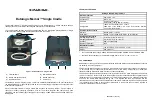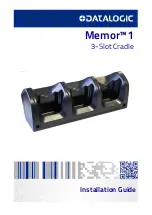
The batteries should be inserted into the third outside transmitter at the latest within
10 seconds after reception of outside area data from the second outside transmitter.
8.
To ensure a sufficient 868 MHz signal transmission, it is necessary to maintain a distance of
no more than 100 meters under good conditions between the final installation locations of
the weather station and the outside transmitter (see note under “Placement” and “868 MHz
reception”).
If the description above for setting of additional outside transmitters is not correctly
followed, transmission problems can arise. If such problems arise, removal of the
batteries from all units and a new setting from Step 1 are required.
If the battery output is insufficient, a battery status symbol is displayed. The battery symbol in the
“Indoor” area (upper right) indicates that the batteries of the weather station should be replaced;
the battery symbol in the “Outdoor” area (lower right) applies to outside transmitter.
b) Adjustment of the temperature unit
The temperature display is preset to °C (Celsius) units.
1. To switch the display to °F (Fahrenheit), push and hold the SET/CH key
for about 3 seconds to enter manual setting mode; the temperature display
°C / °F flashes.
2.
When the display flashes, use the + key to switch between “°F” and “°C.”
3.
Press the SET/CH key to confirm the selection and to enter the “Setting 12/24-hour display
format” mode.
c) Setting time display format (12/24-hour)
1.
“12h” or “24h” will flash on the LC display (default 24h).
2. Use the “+” - key to set the display mode to “12h” or “24h.”
3.
Press the SET/CH key again to confirm the selection and to
enter the “Manual time setting” mode.
d) Time setting
1.
Pressing the SET/CH key again makes the hour figures flash.
2. Use the “+” key for setting the hours.
3. Then press the SET key in order to get into the setting
mode for the minutes; the minute figures flash. Use the
“+” key for setting the minutes.
28
















































